CBSE All India Paper Of Class 10 Science - 2017 (With Solutions) | Past Year Papers for Class 10 PDF Download
Ques 1: Write the molecular formula of the 2nd and the 3rd member of the homologous series whose first member is methane.
Ans: The general formula for the homologous series whose first member is methane is CnH2n+2.
The two consecutive members (2nd and 3rd) of this series are:
a. CH3CH3 (Ethane); where n is 2
b. CH3CH2CH3(Propane); where n is 3
The molecular formulae are C2H6 and C3H8 respectively.
Ques 2: When a cell reproduces, what happens to its DNA?
Ans: During the process of reproduction, transmission of DNA from parents to offspring takes place. Before reproduction, DNA is replicated, which means two copies of DNA are produced. When the cell divides into two, these two copies are distributed equally between the two daughter cells so that similar amount and type of DNA is transferred from the parent cell to the daughter cells. It maintains the consistency in the amount and type of DNA in the living organism of a particular species.
Ques 3: State two advantages of conserving (i) forests, and (ii) wild-life.
Ans: There are innumerable advantages of conserving forests, such as:
1. It supports life, helps in maintaing the quality of air, water and basic essentials of existence of life.
2. Stability in soil is possible by trees. It enables the land based plants and animals to live.
3. Forests also supply raw materials to many industries, such as wood, spices, medicinal herbs, etc.
Advantages of conserving wildlife:
1. It helps in maitaining ecological balance and biodiversity.
2. We depend upon wildlife for food, clothing, medicines and many other products.
Ques 4: Explain two main advantages associated with water harvesting at the community level.
Ans: Two advantages associated with water harvesting at community level are:
1. Water harvesting is an ideal solution to water problems in areas having inadequate water resources. It mitigates the effect of drought.
2. It improves the quality of water and helps in raising ground water levels.
Ques 5: Write the structural formula of ethanol. What happens when it is heated with excess of conc. H2SO4 at 443 K? Write the chemical equation for the reaction stating the role of conc. H2SO4 in this reaction.
Ans: Structural formula of ethanol is CH3CH2OH.
When ethanol is heated with excess of conc. H2SO4 at 443 K results in the dehydration of ethanol to give ethene. Role of conc. H2SO4: Concentrated sulphuric acid acts as a dehydrating agent which removes water from the ethanol molecule in the reaction.
Role of conc. H2SO4: Concentrated sulphuric acid acts as a dehydrating agent which removes water from the ethanol molecule in the reaction.
Ques 6: Distinguish between esterfication and saponification reaction with the help of the chemical equations for each. State one use of each (i) esters, and (ii) saponification process.
Ans: Esterification reaction is opposite/reverse of saponification reaction.
In esterification, a carboxylic acid and an alcohol react to form ester in presence of acid. Whereas, in saponification reaction an ester reacts with a strong base or an acid to give alcohol and carboxylic acid.
Whereas, in saponification reaction an ester reacts with a strong base or an acid to give alcohol and carboxylic acid.
RCOOR′ + NaOH → RCOONa + R′OH
(i) Use of Esters: Esters are used in making perfumes.
(ii) Use of Saponification Reaction: This reaction is used in the preparation of soap and soap products on a large scale.
Ques 7: Write the number of periods and groups in the Modern Periodic Table. How does the metallic character of elements vary on moving (i) from left to right in a period, and (ii) down a group? Give reason to justify your answer.
Ans: In the Modern Periodic Table, there are 18 vertical columns known as Groups and 7 horizontal rows known as Periods.
Metallic character: It is defined as the tendency of an atom to lose electrons.
Across the period i.e., from left to right: Metallic character decreases
Down the group i.e., from top to bottom: Metallic character increases
Reason: Across the period, the effective nuclear charge increases, thus decreasing its atomic radius. This favours the increase of electronegativity and therefore the tendency to lose electrons is low. This accounts for the decrease in the metallic character along the period. But as we move down the group, the number of shells keep on increasing and therefore the atomic size increases. This means that the electronegativity decreases. This enhances the ability to lose electrons and therefore the metallic character increases down the group.
Ques 8: Na, Mg and Al are the elements of the 3rd period of the Modern Periodic Table having group number 1, 2 and 13 respectively. Which one of these elements has the (a) highest valency, (b) largest atomic radius, and (c) maximum chemical reactivity? Justify your answer stating the reason for each.
Ans: Given: Three elements Na, Mg and Al belonging to group 1, 2 and 13 respectively.
The electronic configurations of the three elements are as follows:
Element Name | Symbol | Atomic Number | Electronic Configuration |
Sodium | Na | 11 | 2,8,1 |
Magnesium | Mg | 12 | 2,8,2 |
Aluminium | Al | 13 | 2,8,3 |
(a) The element having the highest valence signifies the maximum number of electrons present in the valence shell of an atom. Hence, as per the electronic configurations, the element having highest valency is aluminium (Al).
(b) As we move across the period, i.e., from left to right the atomic radius of the atoms decrease. Therefore the element having the largest atomic radius will be sodium (Na).
(c) The given three elements are metals. So, the chemical reactivity of a metal is determined by its metallic character which is the tendency of an atom to lose its electrons. We know that, the metallic character of element decreases across the period, i.e., from left to right. So, the element having highest chemical reactivity is sodium (Na).
Ques 9: Reproduction is one of the most important characteristics of living beings. Give three reasons in support of the statement.
Ans: Reproduction is an energy consuming process which is not essential for the survival of an individual. But it is a highly important characteristic of all the living beings, because of the following reasons:
1. Reproduction helps in increasing the number of members of a population.
2. By replacing the dead members with the new ones, it minimizes the risk of extinction of a species.
3. It brings about variations in species, thus, leading to their evolution.
Ques 10: What is vegetative propagation? State two advantages and two disadvantages of this method.
Ans: Vegetative propagation is a mode of asexual reproduction in which new plants are obtained from vegetative parts of the plants. It does not involve the production of seeds or spores for the propagation of new plants.
Two advantages of vegetative propagation are:
1. Plant which do not produce seeds are propagated by this method, for example, sugarcane, potato, etc.
2. Vegetative propagation is a cheaper, easier, rapid method of propagation in plants than growing plants from their seeds. For example, lilies grow very slowly and take 4 to 7 years to develop flowers when grown with their seeds, but flowers are produced only after a year or two when grown vegetatively.
Two disadvantages of vegetative propagation are:
1. As there is no genetic variation, there is no chance of development of new and better varieties.
2. The vegetatively propagated plants are more prone to diseases that are specific to the species. This can result in the destruction of an entire crop.
Ques 11: List three techniques that have been developed to prevent pregnancy. Which one of these techniques is not meant for males? How does the use of these techniques have a direct impact on the health and prosperity of a family?
Ans: Three techniques that have been developed to prevent pregnancy are:
(i) Mechanical methods: Include condoms, diaphragms, IUDs, etc
(ii) Chemical methods: Include oral contraceptive pills, spermicides, etc
(iii) Surgical methods: Include vasectomy and tubectomy
Out of all these, chemical methods are not meant for males.
The use of such contraceptive methods have various benefits, such as:
(i) Large size of families has a negative impact on the economic status of the family. Use of contraception helps in reducing the family size and, thus, increases its prosperity.
(ii) Having pregnancies at quick succession reduces mother's health and vitality. Use of contraceptive devices, thus, help a lot in improving the maternal health status.
(iii) Some contraceptive devices (such as condoms) are also helpful in preventing sexually transmitted diseases.
Ques 12: How did Mendel explain that it is possible that a trait is inherited but not expressed in an organism?
Ans: Some traits that are inherited may not express themselves. Such hidden traits are known as recessive traits. Mendel explained this phenomenon with the help of monohybrid cross. In a monohybrid cross performed by Mendel, tall plant was crossed with a dwarf plant which produced all tall plants in F1 progeny. However, when these F1 tall plants were crossed with each other, 'dwarf' trait, which was not observed in the F1 generation, reappered in the F2 progeny.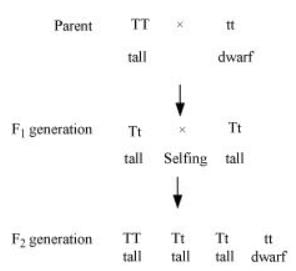 By this, it is concluded that dwarfness traits of parent pea plant were not lost. They were suppressed in the F1 generation by the tallness traits and reappeared in the F2 generation. So, we can say that a trait that is inherited may not be expressed in an organism.
By this, it is concluded that dwarfness traits of parent pea plant were not lost. They were suppressed in the F1 generation by the tallness traits and reappeared in the F2 generation. So, we can say that a trait that is inherited may not be expressed in an organism.
Ques 13: "Evolution and classification of organisms are interlinked." Give reasons to justify this statement.
Ans: Classification refers to the grouping and naming of organisms based on the similarities and differences in their characters. Classification is done on the basis of ancestral/basic characteristics (that are present in all the members of a population and, thus, form their basic body design) and derived characteristics (that are developed due to evolutionary changes in the ancestral characteristics). So as we move on from simple life forms to the complex organisms, we are actually tracing the path of evolution. All life forms on Earth have progressively changed during evolution. So, the hierarchy developed during classification throws a light on the evolutionary relationships among the organisms.
Common ancestors can also be predicted with the help of classification. The more characters two species have in common, the more closely they are related, and thus, more recently they will have had a common ancestor. For example, a brother and sister are very much closely related, as they have common ancestor, i.e. their parents. The first cousins, on the other hand, are also related, but in lesser degree than the siblings. That's because they have common ancestors in the form of grand parents and not the parents. So, moving backwards in a classification tree can help in finding the common ancestors of different species. Hence, we can say that the evolution and classification of organisms are interlinked.
Ques 14: If the image formed by a lens for all positions of anIf the image formed by a lens for all positions of an object placed in front of it is always erect and diminished, what is the nature of this lens? Draw a ray diagram to justify your answer. If the numerical value of the power of this lens is 10 D, what is its focal length in the Cartesian system ?
Ans: The type of the lens is concave lens.
Ray diagram is shown below: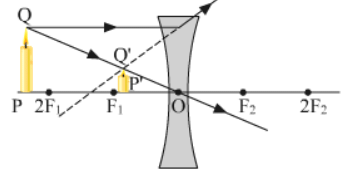 Since, power of a lens is given by the relation
Since, power of a lens is given by the relation p = 10 D (given)
p = 10 D (given) Therefore, the focal length of the lens is - 0.1 m as the lens is concave in nature.
Therefore, the focal length of the lens is - 0.1 m as the lens is concave in nature.
Ques 15: State the cause of dispersion of white light by a glass prism. How did Newton, using two identical glass prisms, showed that white light is made of seven colors? Draw a ray diagram to show the path of a narrow beam of white light, through a combination of two identical prisms arranged together in an inverted position with respect to each other, when it is allowed to fall obliquely on one of the faces of the first prism of the combination.
Ans: Cause of dispersion: When a beam of white light enters a prism, it gets refracted at point and splits into its seven constituent colours, viz. violet, indigo, blue, green, yellow, orange, and red. The acronym for the seven constituent colours of white light is VIBGYOR. This splitting of the light rays occurs because of the different angles of bending for each colour and this different angles of bending occurs because different component of light faces different refractive indices when passing through the glass prism.
First, Newton made white light to fall on a prism. This caused the dispersion of white light into seven colours. Newton then placed an inverted prism in the path of a colour band of seven colours. He was amazed to see that only a beam of white light comes out from the second prism. It was at this point that Newton concluded that white light comprises of seven component colours.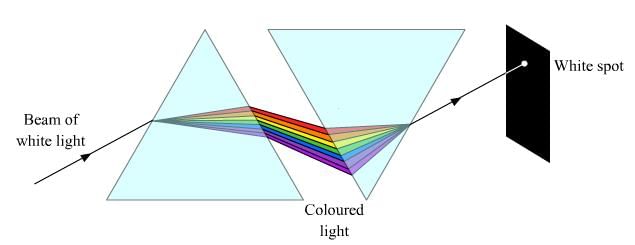
Ques 16: (a) Water is an elixir of life, a very important natural resource. Your Science teacher wants you to prepare a plan for a formative assessment activity, "How to save water, the vital natural resource". Write any two ways that you will suggest to bring awareness in your neighbourhood, on 'how to save water'.
(b) Name and explain any one way by which the underground water table does not go down further.
Ans: (a) Water is one of the most precious natural resources that has varied importance in our lives. It is an essential component of the human body, and is used almost everywhere in our day-to-day activities, such as cooking, washing, in agriculture and industries. It is an indispensable part of our lives, without which the life on earth is not possible. However, the amount of fresh water available for sustaining life is very less. So, it is very important to save water. For that, we can adopt following two ways:
(i) Reduce the consumption: It can be done by turning off the taps during brushing or washing clothes/utensils, or by using buckets instead of showers for bathing, etc.
(ii) Reusing the water: The water used for washing fruits and vegetables can be saved and used for other purposes, like washing cars, watering the flower pots, etc.
(b) Underground water table can be recharged through rainwater harvesting. Rainwater harvesting is a process by which rain water is collected and stored for the purpose of recharging the ground water or for future use like for irrigation and agriculture, for livestock, etc. In India, rainwater harvesting is an old tradition, which is followed till now in many parts of India. For example, bawris are traditional architectural rainwater harvesters that were built for collecting water, in the state of Rajasthan.
There are two ways of rainwater harvesting:
(i) Surface runoff harvesting: In urban areas, rain water that flows away from the surface can be collected and used for various purposes.
(ii) Rooftop rainwater harvesting: The rainwater on the roofs of the buildings is collected through canals that drain the water into ground reservoirs. This stored water is later utilised.
Ques 17: (a) Write the functions of each of the following parts in a human female reproductive system:
(i) Ovary
(ii) Uterus
(iii) Fallopian tube
(b) Write the structure and functions of placenta in a human female.
Ans: (a) Functions of the Ovary:
(i) It produces female gametes (ova).
(ii) It secretes female sex hormones (estrogen and progesterone).
Functions of the Uterus:
(i) It supports and nourishes the developing foetus.
(ii) It expands according to the growth of the baby.
Functions of Fallopian tubes:
(i) They carry eggs from the ovary to the uterus.
(ii) They act as the site of fertilisation.
(b) Placenta is the connecting link between the mother's body and the baby. It is a disc embedded in the uterine wall. This special tissue contains villi on the embryo’s side of the tissue and on the mother’s side are blood spaces, which surround the villi. Placenta functions as a site of exchange of materials between the blood of mother and foetus. It provides a large surface area for glucose and oxygen to pass from the mother to the baby. The developing embryo generates certain waste substances that are also removed through placenta. Thus, the placenta serves as the nutritive, respiratory and excretory organ of the foetus.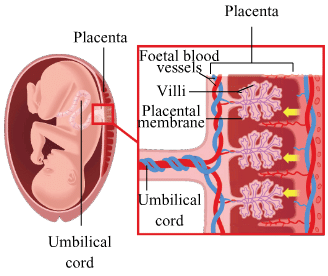
Ques 18: Write the help of one example for each, distinguish between the acquired traits and the inherited traits. Why are the traits/experiences acquired during the entire lifetime of an individual not inherited in the next generation? Explain the reason of this fact with an example.
Ans: Differences between acquired and inherited traits are as follows:
Acquired Traits | Inherited Traits |
Acquired traits are those that are developed by an individual during his/her lifetime. | Inherited traits are the qualities or characteristics present in an individual since birth. |
They are a result of changes in non-reproductive tissues (somatic cells). | They are a result of changes in the DNA. |
They cannot be passed on to the progeny. | They are transmitted to the progeny. |
Examples: Pierced ear, large muscle size, etc | Examples: Colour of eyes, skin or hair |
Traits can be passed on to the next generation only when they have some direct effect on the genes. The traits acquired during the lifetime of an individual cannot be inherited as they do not affect the genetic make up of an organism. In fact, these traits develop due to use and disuse of organs, or due to direct affect of environment. Thus, they are not passed on to the next generation. For example, a wrestler develops large muscles because of his training programme; it does not mean that his offspring will necessarily have large muscles. Similarly, if a lady pierces her nose, the children produced to her will not have pierced nose by birth.
Ques 19: Analyze the following observation table showing variation of image-distance (v) with object-distance (u) in case of a convex lens and answer the questions that follow without doing any calculations :
S. No. | Object-Distance | Image-Distance |
1 | –100 | +25 |
2 | –60 | +30 |
3 | –40 | +40 |
4 | –30 | +60 |
5 | –25 | +100 |
6 | –15 | +120 |
(a) What is the focal length of the convex lens? Give reason to justify your answer.
(b) Write the serial number of the observation which is not correct. On what basis have you arrived at this conclusion?
(c) Select an appropriate scale and draw a ray diagram for the observation at S.No. 2. Also find the approximate value of magnification.
Ans: (a) From S.No 3 we can say that the radius of curvature of the lens is 40 cm because when an object is placed at the centre of curvature of a convex lens its image is formed on the other side of the lens at the same distance from the lens. And, we also know that focal length is half of the radius of curvature. Thus, focal length of the lens is + 20 cm.
(b) S.No: 6 is not correct as for this observation the object distance is between focus and pole so for such cases the image formed is always virtual but in this case a real image is forming as the image distance is positive.
(c) Approximate value of magnification for object distance - 60 cm and image distance + 30 cm is - 0.5.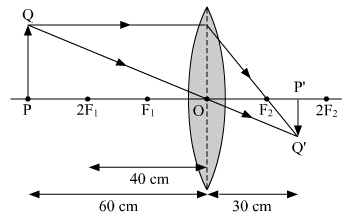
Ques 20: When you add a few drops of acetic acid to a test-tube containing sodium bicarbonate powder, which one of the following is your observation?
(A) No reaction takes place
(B) A colourless gas with pungent smell is released with brisk effervescence
(C) A brown coloured gas is released with brisk effervescence
(D) Formation of bubbles of a colourless and odourless gas
Ans: When a few drops of acetic acid added to a test-tube containing sodium bicarbonate powder its leads to the formation of sodium acetate along with release of carbon dioxide gas, which is colourless and odourless gas. Both solid sodium bicarbonate and its aqueous solution will react with acetic acid. Following is the chemical equation for the reaction:
CH3COOH + NaHCO3 → CH3COONa + CO2 + H2O
Hence, the correct answer is option (D).
FAQs on CBSE All India Paper Of Class 10 Science - 2017 (With Solutions) - Past Year Papers for Class 10
| 1. What is the CBSE All India Paper of Class 10 Science? |  |
| 2. How can I access the CBSE All India Paper of Class 10 Science from 2017? |  |
| 3. Why is it important to solve the CBSE All India Paper of Class 10 Science from 2017? |  |
| 4. Are solutions available for the CBSE All India Paper of Class 10 Science from 2017? |  |
| 5. Can solving the CBSE All India Paper of Class 10 Science from 2017 guarantee good marks in the actual board exam? |  |
















